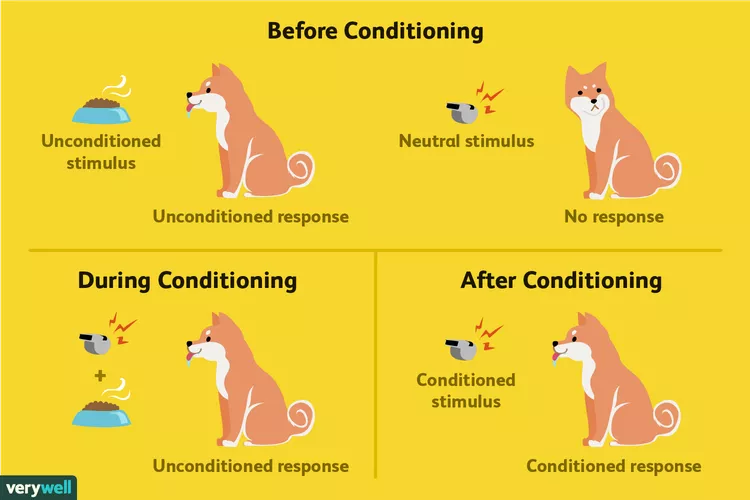Psychology Module 7: Learning Theory
1/24
There's no tags or description
Looks like no tags are added yet.
Name | Mastery | Learn | Test | Matching | Spaced |
|---|
No study sessions yet.
25 Terms
What is Habituation?
It is when you get used to something and stop reacting over time. For example, the first time you hear a car honk, you might get startled. But after hearing it multiple times, you get used to it and stop paying attention. This is helpful for simple learning. Basically, it means we ignore old information we are already familiar with.
What is dishabituation?
After you get used to something, you suddenly notice a change. For example, if you’re used to loud car honks and they suddenly stop, you immediately react to the change. This encourages curiosity to new and potentially useful information.
Classical Conditioning
Connecting two experiments to understand them better. For example, Ivan Pavlov rang a bell and then gave a dog food. After repeating this multiple times, the dog eventually treated the bell as a signal for food.

What are the five steps for Classical conditioning?
Unconditional stimulus (UCS)
Unconditional Response (UCR)
Neutral Stimulus (NS)
Conditional Stimulus (CS)
Conditional Response (CR)
Unconditional Stimulus and Unconditional Response
(UCS)-Something that naturally causes a response. For example, in Pavlov's experiment, the food naturally makes the dog drool.
(UCR)- It is a natural reaction. For example, Pavlov’s experiment, the dogs drooling is the natural reaction to seeing food.
Neutral Stimulus
Does not cause a response on its own. For example, in Pavlov’s experiment, the bell at first does not make the dog drool.
Conditional Stimulus and Conditional Response
(CS)- Leads to a learned response. For example, in Pavlov’s experiment, after repeatedly pairing the dog with food, the dog began to react to the bell alone.
(CR)- A learned response that develops where no response existed before. For example, in Pavlov’s experiment, the dog drooled when it heard the bell, even when no food was present.
Behaviorist
A study of learning and education. They believe that any person can be trained to perform any task, as long as their body is capable of performing it.
Transformative Learning Experience
They are experiments that learners follow to help them get new information. For example, a person struggles to cook for their family but improves by learning about habit formation.
Modern learning theory
A new method that enhances learning engagement through technology, such as online books, Google docs, and Zoom meetings.
Stimulus Generalization
When an organisms responds to a new but similar stimulus the same way as the original one. For example, in Pavlov’s experiment, a dog might be conditioned to respond to a bell even though they aren’t the same pitch.
Extension
A conditioned response fades or disappears without reconditioning. For example, in Pavlov’s experiment, he kept ringing the bell but never gave the dog any food afterwards. Eventually, the dog stopped drooling when it heard the bell.
Operant Conditioning
A learned process that uses rewards and punishment to change behavior. For example in a rat experiment, a rat in a laboratory learns to press a lever in a cage. The rat learns the connection between pressing the lever and getting food. For example the rat learned that once it hits the lever is receives a piece of food.
Consructivism
It is not always about memorizing facts. Learning is more than gaining knowledge; it is an active process based on personal experiences, where knowledge is actively built. For example, a student gains understanding by learning problem-solving situations, the true context such as experiment, real world problem-solving projects, and opportunity for discovery.
Spontaneous Recovery
A learned response returns even after a extinction.
Thorndike’s Law Effect
When a behavior has a positive effect it is likely to be repeated. When a behavior has a negative consequence it is likely to be repeated.
Reinforcement vs. Punishment
Reinforcers increase behaviors, while punishers decrease behaviors. A reinforcer could be positive or negative. For example, positive reinforcers strengthen a response through a reward, while a negative reinforcers, increases a behavior by removing an aversive or upsetting stimulus. For instance, an annoying bell makes you mad, you turn it off to stop the irritation.
Cognitivism
Learning also involves inner mental activity, including Improving attention, memorization, organization, and problem solving.
Applied Behavioral Analysis (ABA)
Relies heavily on reinforcement and conditioning to help treat individuals with autism spectrum disorders, particularly improving language deficits. For example, it can help children with autism improve their communication skills.
Humanism
Learning is a personal act aimed at fulfilling one’s potential. It plays a key role in both school and life success. Individuals gain self-esteem when they receive feedback or guidance. Curiosity is also important for the learning process.
Behaviorism
Learning only has to do with observable behavior.
Obsvational Learning
Individuals learn by observing the behaviors of others.
Habituation
Habituation is when you get used to something after experiencing it many times, so you start noticing it less and reacting to it less.